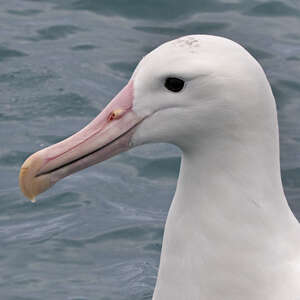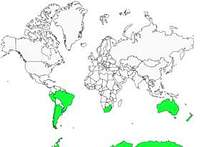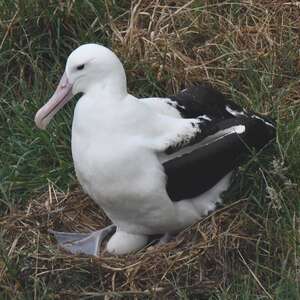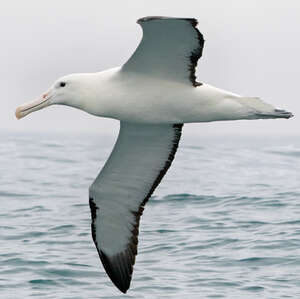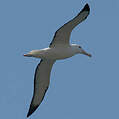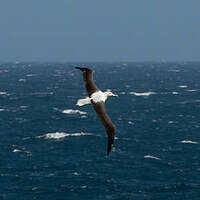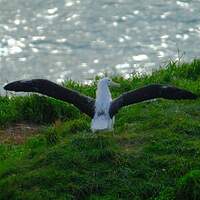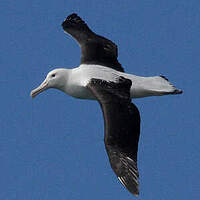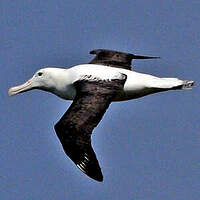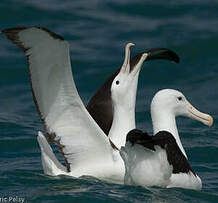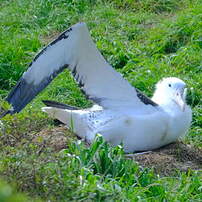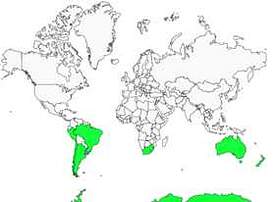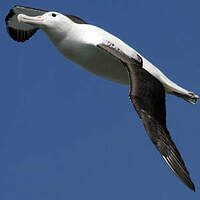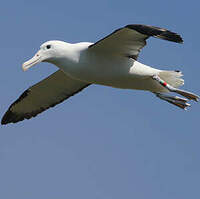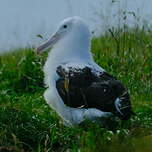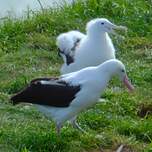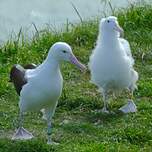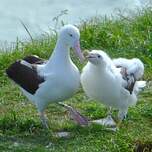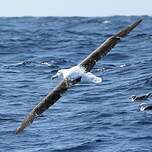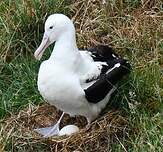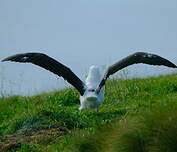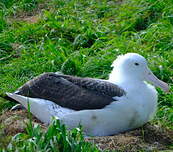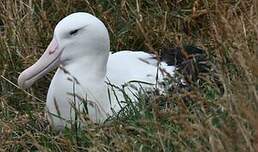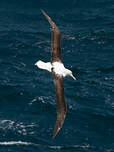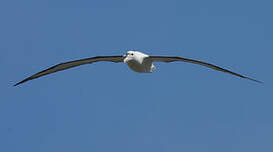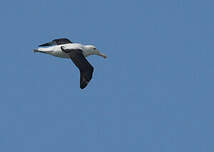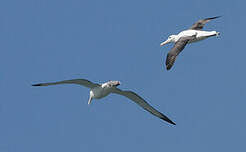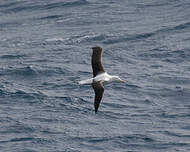Northern Royal Albatross
Diomedea sanfordi - Albatros royal du Nord Albatros de Sanford
Identification
The Northern Royal Albatross is a large albatross. Its wingspan can reach up to 350 cm. The adult has a white body and head. The long and narrow wings are black above and white below with a black tip and narrow outer edge. The tail feathers often have a black tinge. The long, strong and hooked beak is pale pink. The legs are flesh coloured. The nudity are more brightly coloured during the breeding season. There is a slight sexual dimorphism. Males are slightly larger than females. The latter may have black spots on the crown. The juvenile resembles the adult, but with dark marks on the head, back and tail and light marks on the wings.
Subspecific information monotypic species
Foreign names
- Albatros royal du Nord,
- Albatros real septentrional,
- albatroz-real-setentrional,
- Schwarzflügelalbatros,
- Noordelijke Koningsalbatros,
- Albatros reale del nord,
- nordlig kungsalbatross,
- albatros sépiar,
- albatros Sanfordův,
- Nordlig Kongealbatros,
- Swartvlerkkoningalbatros,
- albatros reial septentrional,
- albatros ciemnoskrzydły,
- Северный королевский альбатрос,
- キタシロアホウドリ,
- 北皇信天翁,
- nordlig kungsalbatross,
- 北方皇家信天翁,
Voice song and call
Habitat
Two habitats are occupied; the high seas throughout the year for foraging, and islands for breeding. On land, the Northern Royal Albatross is generally found on grassy slopes with clumps of vegetation providing shelter, but often in exposed locations,wave-beaten ridges and hummocks, aiding in takeoff.
Behaviour character trait
This Northern Royal Albatross is like other albatrosses a solitary wanderer who can disperse throughout the entire Southern Ocean. It spends most of its existence at sea, coming to land only for reproduction. Its adaptation to the marine environment is extreme. During the breeding season, the breeding adults feed on the continental shelves in New Zealand waters. Unlike other albatrosses, it does not follow ships, except fishing boats that may provide it with food.
Flight
Dietfeeding habits
Foraging usually occurs in isolation, but they also gather around sources of food. Their prey is mainly cephalopods and, to a lesser extent, fish, crustaceans and salps, which are taken at the surface and up to one metre deep with short dives. It also scavenges willingly. Thus, close to one third of the cephalopods consumed by the Northern Royal Albatross of Taiaroa are benthic squid presumably trapped in fishing pots and thrown away.
Reproduction nesting
This species is monogamous and colonial for reproduction. The couple is, unless something unexpected happens, together for life.
And because a reproductive season extends for almost 11 months (July of one year to June of the following year), they usually reproduce only every two years.The nest is a 60cm-diameter, 8cm-tall mound made of a bit of vegetation, soil, or small stones. The single egg is laid from October to November. The egg is white with reddish spots on the larger end. The incubation period of around 80 days is taken care of by both adults, who switch off at the nest every 2-3 weeks. Hatching takes place at the end of January or the beginning of February. The nestling will be watched over and protected for another 40 days and then left alone. It is fed only on average every two days, but its meals are plentiful (400 to 900 grams). It leaves the nest at about 240 days old when it can already fly. It won't come back to the nest until the age of 3-4 years, but it won't reproduce for the first time until the age of 8, on average. The species is called the Northern Royal Albatross.
Geographic range
Endemic to New Zealand, Northern Royal Albatrosses mainly breed on the Chatham Islands, with a small breeding colony near Dunedin on the Otago Peninsula. The breeding population in the Chatham Islands (99% of the total) is estimated to be 6,500 to 7,000 pairs, equating to an approximate mature population of 17,000 individuals. Approximately 1% of the population, or 30 pairs, breed each year at Taiaroa. Although this colony is increasing, trends for the total population are unknown due to lack of recent data from the Chatham Islands.
Non-breeding and immature albatrosses occupy most of the Southern Ocean with them rarely being seen in the Antarctic waters. Primary wintering areas are found off the coast of the south of South America. During breeding time, they mainly feed off the Chatham Islands located 800 km to the east of the South Island and do not venture past East Cape on the North Island. The majority of the population spend the inter-breeding period offshore of both South American coasts, particularly over the Chilean Continental Shelf and the Patagonian Shelf off the coast of Argentina.
Threats - protection
IUCN conservation status
concern
in the Wild
threatened
evaluated
The species is classified as endangered. Climate change could become the main threat to the species. Reproduction success in the Chatham Islands colonies has significantly reduced following a major storm in 1985 which caused the loss of soil and vegetation. Since the mid-1970s, the Chatham Islands and Taiaroa Head colonies have experienced warming and drying of the habitat. More recently a hot and dry episode led to nesting failure. In response, a sprinkler system was installed to cool nesting birds on particularly hot days. In addition, a fly repellent has been used to reduce the risk of infestation. There are no introduced mammals on the small islands where the Northern Royal Albatross nest in the Chatham Islands. At Taiaroa Head, vandalism has been non-existent since 1937 and predation of chicks by introduced mammals has been prevented by destruction of the latter and protection of the site. Mortality due to fishing is not considered an important problem.
Sources of information
- IOC World Bird List (v15.1), Gill, F and D Donsker (Eds). 2025-12-07.
- Field Guide to New Zealand Seabirds, Parkinson Brian
- Handbook of Australian, New Zealand and Antarctic birds, 1: ratites to ducks., Marchant, S.; Higgins, P. J.
- Know your New Zealand Birds, Lynnette Moon
- The field guide to the birds of New Zealand., Heather, B. D.; Robertson, H. A.
- The State of New Zealand's Birds 2005., Wilson, K-J.
- Vol. 1 - Handbook of the Birds of the World, Josep del Hoyo-Andrew Elliot-Jordi Sargatal
- ARKive, Christopher Parsons
- Avibase, Lepage Denis
- HBW Alive,
- IUCN Red List of Threatened species,
- New Zealand birds and birding, Narena Olliver
- xeno-canto, Sharing bird sounds from around the world,
Other sources of interest
 Specification sheet created on
30/07/2023 by Yann Cambon
Specification sheet created on
30/07/2023 by Yann CambonTranslation by AI Oiseaux.net
© 1996-2025 Oiseaux.net
- Accipitriformes
- Aegotheliformes
- Anseriformes
- Apodiformes
- Apterygiformes
- Bucerotiformes
- Caprimulgiformes
- Cariamiformes
- Casuariiformes
- Charadriiformes
- Ciconiiformes
- Coliiformes
- Columbiformes
- Coraciiformes
- Cuculiformes
- Eurypygiformes
- Falconiformes
- Galliformes
- Gaviiformes
- Gruiformes
- Leptosomiformes
- Mesitornithiformes
- Musophagiformes
- Nyctibiiformes
- Opisthocomiformes
- Otidiformes
- Passeriformes
- Pelecaniformes
- Phaethontiformes
- Phoenicopteriformes
- Piciformes
- Podargiformes
- Podicipediformes
- Procellariiformes
- Psittaciformes
- Pterocliformes
- Rheiformes
- Sphenisciformes
- Steatornithiformes
- Strigiformes
- Struthioniformes
- Suliformes
- Tinamiformes
- Trogoniformes

